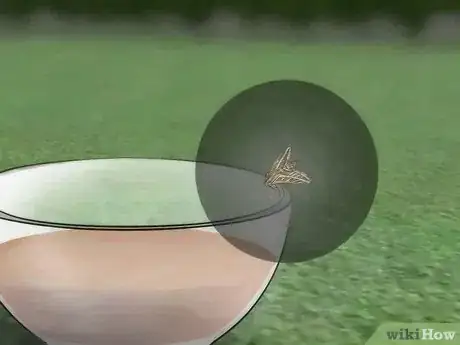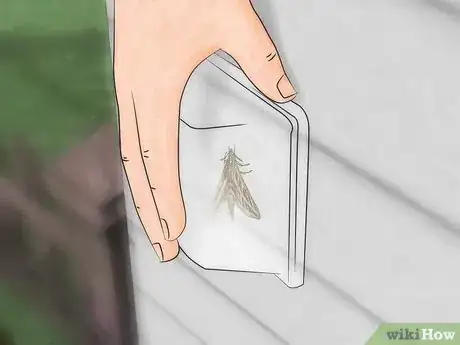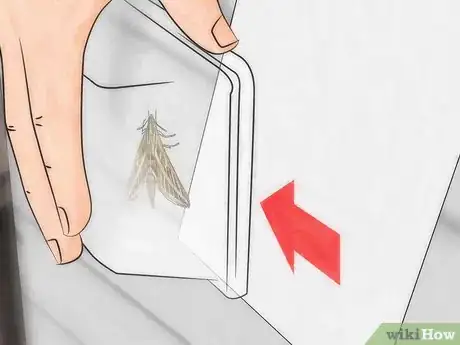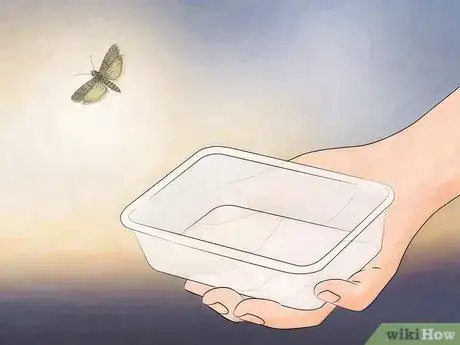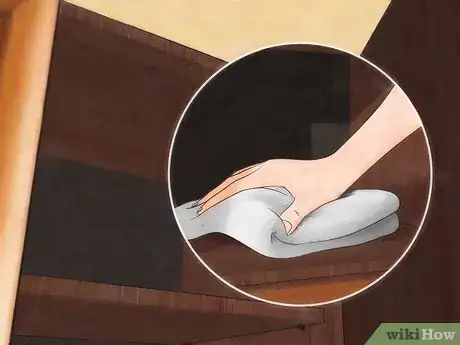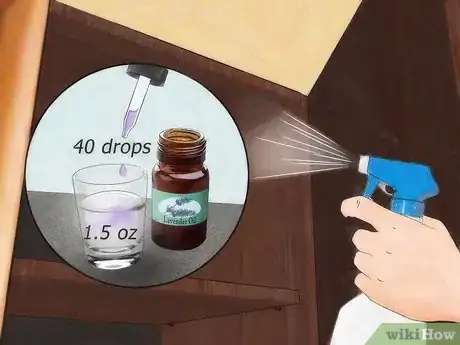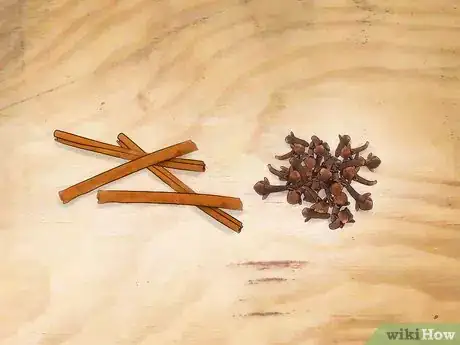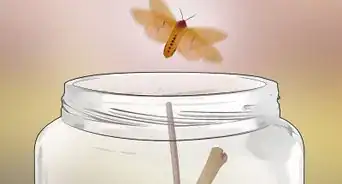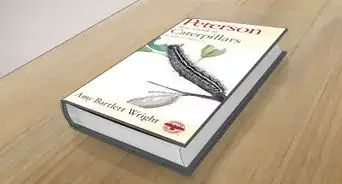This article was co-authored by wikiHow Staff. Our trained team of editors and researchers validate articles for accuracy and comprehensiveness. wikiHow's Content Management Team carefully monitors the work from our editorial staff to ensure that each article is backed by trusted research and meets our high quality standards.
There are 11 references cited in this article, which can be found at the bottom of the page.
This article has been viewed 75,074 times.
Learn more...
Moths are a common insect that many people consider a pest. Other individuals enjoy observing one of the many species of moths because they are related to butterflies. By constructing a trap, capturing any moths you want, and repelling them, you can keep the number of moths in your vicinity in check.
Steps
Capturing a Moth
-
1Learn about moth behavior. Acquaint yourself with moth behavior before you begin catching the insects. This may help you more effectively catch a moth or moths.
- Moths are generally nocturnal, which means they mostly fly at night.[1] However, some species, like the buck moth, that are diurnal, meaning they fly both day and night.[2]
- Moths prefer warm, humid and overcast nights to cooler, clear nights.[3]
- There are thousands of species of moths and butterflies. Some eat plants, while others may eat wool and items of clothing.
- Contact your local county extension to help identify any moths you may have in or around your home.[4]
-
2Gather equipment. You’ll need a few items to most effectively catch a moth. By gathering the following materials before you start, you may be able to catch one—or many—moths:Advertisement
-
3Bait moths you want to catch. “Baiting”, which is also called “sugaring” is a technique you can use to attract moths you want to catch. Baiting involves making “moth food” and putting in places to attract moths.[7]
- Make bait by mixing one can of beer or apple cider, 1.5 cups sugar, ¼- ½ cup molasses, four over-ripe bananas or other fruit such as apples or peaches in a blender. You can also add a spoonful of cornmeal and some brewer’s yeast if you like, too.[8]
- Place fermenting fruits like spoiled watermelon as another form of bait.[9]
- Remember that moths are also attracted to any kind of light, so you can seek them near outdoor or indoor lights if you wish.[10]
- Apply an approximately 20-30cm patch of bait to tree trunks with a brush just before sunset.[11] Find trees with smooth bark or plates of smooth bark such as pine, hickory, cherry, or birch.[12]
- Fill a small bowl or your container with bait if you want to catch the moth in your home.
- Be aware that bait can attract more than moths. Bears, mice, skunks, and foxes may like your bait in addition to the moths you want to catch.[13]
-
4
-
5Approach the moth slowly. Wait until the moth or moths are at rest or not moving before you catch them. Once you’ve observed them, approach them slowly so that you don’t startle them away.
- Avoid sudden movements, which may startle moths into flight.
- Approach the moth from behind if you can.
-
6Catch the moth. Take out your net or container and sweep it forward quickly. This can help you effectively capture the moth in your container without releasing it.
- Make secure to quickly secure the container over the moth so that it can’t escape.
- Ensure that the moth is at the deep or far end of your container to minimize the risk of it escaping.
-
7Seal the container. Once you’ve captured the moth, seal your net or container. This can help you transport the moth so that you can release it or observe it.
- If you’re using a net, collapse the end of it with your fingers. Leave enough space at the end of the net to minimize the risk of damage to the moth.
- If you’re using a jar, box, or another container, slowly thread a piece of paper or a lid under it. Make sure to not lift the container up too high so that the moth doesn’t escape.
-
8Release the moth. After you’ve caught the moth and observed it if you want, release it into the outdoors or someplace outside your home where it won’t bother you any longer. This is a more humane way to deal with a moth than killing it.
Repelling Moths
-
1Inspect and clean your spaces regularly. Set up regular inspections and clean sessions of spaces that attract moths. This can help you nip problems in the bud before they become infestations and kill larvae.
- Check closets, human and pet bedding, behind furniture, in curtains, behind radiators or heaters, in air ducts and vents, and along baseboards.
- Wipe down and vacuum areas attractive to moths at least once a week.
- Clean your clothes regularly as well. Moths are attracted to garments soiled by food, drinks, sweat, and urine.
-
2Store items in airtight containers. If you are concerned about clothing, fabric, or other material getting infested by moths, store them in airtight containers. This may kill any moths current residing in your belongings and prevent them from reproducing.
- Store your items below 40 degrees Fahrenheit if possible.
-
3Scatter mothballs. Distribute mothballs in places that currently have a moth infestation or where you’d like to deter them. You may want to consider this as a last resort before professional extermination because mothballs come with an unpleasant smell and can have health side effects.
- Inhaling the vapors from mothballs over a longer period of time can have health consequences. These include: anemia, liver damage, neurological damage, and cataracts.
- Ensure that spaces where you place mothballs are airtight to help prevent you from inhaling the vapors.
-
4Mix a lavender spray. There is some evidence that lavender repels moths. Mixing a lavender spray may help you keep any moth infestations at bay.[16]
- Mix 30-40 drops of lavender essential oil with 1.5 ounces of distilled water. Use a clean spray bottle.[17] The stronger you want the spray, the more oil you will mix with water.[18]
- Boil 3-4 cups of distilled water and 3-4 tablespoons of dried lavender to make a spray with lavender you purchase or grow at home. Strain leaves from the mixture and allow it to cool before using it. [19]
- Spray the mixture wherever you want to repel moths. Avoid dousing material, which may promote the growth of mold.[20]
-
5Grow lavender in your garden. Add some lavender plants in and around your home. It can help not only repel moths from your spaces, but it will also leave a pleasant scent.[21]
-
6Try other natural moth repellants. There is some evidence that other natural herbs, such as cloves, may repel moths from your home. Set a small amount of these herbs in places where you have moths.[22]
-
7Zap moths with a black light and lure. Studies have shown that using a bug zappers in conjunction with a pheromone lure may help kill moths.[25] Consider buying a zapper and pheromone lure if you have a moth problem outside.
- Get a high voltage electronic black light.[26]
- Purchase a pheromone lure at a home or hardware store.
- Use these items in conjunction with one another for optimal results. There is some evidence that a pheromone lure may not work effectively on its own.
-
8Ignite a citronella candle. There is some evidence that burning citronella candles may control insect infestations.[27] Burn citronella candles in areas where you want to repel moths.
Community Q&A
-
QuestionHow can I separate a male from a female? As in, what are the differences between males and females?
 Community AnswerA male is shorter than a female moth, females are bigger. Males are active and females are sluggish.
Community AnswerA male is shorter than a female moth, females are bigger. Males are active and females are sluggish. -
QuestionWhat if I want to breed them?
 Community AnswerYou will have to have ones of the opposite genders. Separate into groups of two in separate cages. Keep a cage of them in a well-ventilated, dark place if they begin mating, and provide plenty of the host plant for the eggs to be laid on. The female may lay hundreds of eggs, so be prepared.
Community AnswerYou will have to have ones of the opposite genders. Separate into groups of two in separate cages. Keep a cage of them in a well-ventilated, dark place if they begin mating, and provide plenty of the host plant for the eggs to be laid on. The female may lay hundreds of eggs, so be prepared.
References
- ↑ http://www.loc.gov/rr/scitech/mysteries/butterflymoth.html
- ↑ http://www.loc.gov/rr/scitech/mysteries/butterflymoth.html
- ↑ http://jpgmag.com/stories/7053
- ↑ http://www.butterfliesandmoths.org/faq/i-have-moths-my-home-what-are-they
- ↑ http://nationalmothweek.org/finding-moths-2/
- ↑ http://nationalmothweek.org/finding-moths-2/
- ↑ http://jpgmag.com/stories/7053
- ↑ http://jpgmag.com/stories/7053
- ↑ http://jpgmag.com/stories/7053
- ↑ http://nationalmothweek.org/finding-moths-2/
- ↑ http://jpgmag.com/stories/7053
- ↑ http://jpgmag.com/stories/7053
- ↑ http://jpgmag.com/stories/7053
- ↑ http://jpgmag.com/stories/7053
- ↑ http://nationalmothweek.org/finding-moths-2/
- ↑ http://www.huffingtonpost.com/2012/05/24/get-rid-of-moth_n_1542770.html
- ↑ http://www.aromaweb.com/recipes/ralinen.asp
- ↑ http://www.aromaweb.com/recipes/ralinen.asp
- ↑ http://www.huffingtonpost.com/2012/05/24/get-rid-of-moth_n_1542770.html
- ↑ http://info.achs.edu/blog/green-cleaning-10-essential-oils-that-naturally-repel-insects
- ↑ http://www.huffingtonpost.com/2012/05/24/get-rid-of-moth_n_1542770.html
- ↑ http://www.huffingtonpost.com/2012/05/24/get-rid-of-moth_n_1542770.html
- ↑ http://www.huffingtonpost.com/2012/05/24/get-rid-of-moth_n_1542770.html
- ↑ http://www.huffingtonpost.com/2012/05/24/get-rid-of-moth_n_1542770.html
- ↑ http://members.efn.org/~itech/pdf%20files/Enhanced%20bug%20zapper.pdf
- ↑ http://members.efn.org/~itech/pdf%20files/Enhanced%20bug%20zapper.pdf
- ↑ http://www.ncbi.nlm.nih.gov/pmc/articles/PMC3059459/
- ↑ http://www.ncbi.nlm.nih.gov/pmc/articles/PMC3059459/
- ↑ http://www.ncbi.nlm.nih.gov/pmc/articles/PMC3059459/
About This Article
To catch a moth, make moth bait by mixing beer or apple cider with sugar, molasses, and over-ripe bananas. Next, apply the bait mixture to a tree trunk or leave it out in a bowl at dusk. Once the sun sets, check the bait every 30 minutes for moths to accumulate. Then, wait until the moths are at rest and approach them slowly from behind. Finally, sweep your net forward quickly to capture a moth and secure it in a container. For tips on safely releasing moths that you catch, read on!



